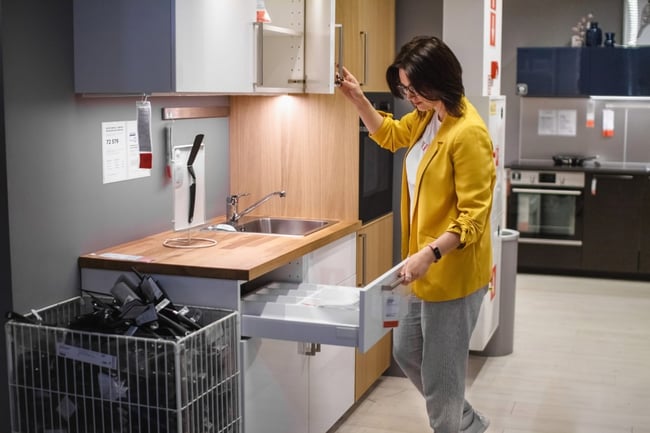Consumer Buying Behaviour Theories & Models Retailers Should Know

Understanding consumer behaviour models and theories can significantly increase your chances of converting high-value customers in a considerably short time frame.
Retailers operating in the home sector, utility companies and even brands providing financial services have a hyper-focused time frame to influence their target audience in the midst of a property move.
According to our retail data, consumers in the year before and after a move spend £12 billion. That's an incredible amount of revenue that you have the chance of taking a chunk out of.
With that said, the significantly tight turnaround often means that a tried and tested marketing approach is necessary, or you risk losing that customer and waiting until they move again. According to the Open Access Government buyer trends, this could be a wait of 23 years.
To increase the chances of successfully converting this target audience, there are some buyer behaviour theories and models you can utilise, which we will cover in this post.
Why do we study the theory of consumer behaviour?

There are numerous reasons why retailers within the home sector need to understand consumer behaviour and leverage it in their marketing campaigns, including:
- Helping to create products that are of superior quality to competitors and are more enticing to your target audience.
- Tailoring marketing communications to create a continuous journey from identification to purchase.
- Considering how external stimuli affect buying behaviour.
In a saturated or competitive market with a short conversion window, you need to meet your customers at every stage of the buying journey to ensure they stick with you over a competitor.
What are the main theories of consumer behaviour?
There are numerous theories when it comes to consumer behaviour. Perhaps the ones most relevant to retailers targeting audiences in the homebuying process include:
Impulse Buying Theory
We’ll begin with the Hawkins Stern Impulse Buying Theory, long used by retailers to increase consumer average order value. This theory is broken down into five approaches:
- Escape purchase process - This is the most impulsive (alongside the suggested purchase process) as it is not something a consumer needs or is thinking about. When purchasing bedroom furniture, for example, a consumer likely won't be thinking about the accessories until the main furniture has been purchased. However, if a product is appealing enough, they may be drawn to it and convinced to invest as an impulse buy.
- Planned purchase process - Seemingly the complete opposite of an escape purchase, this refers to something a consumer was always going to buy eventually but takes action because there's a great deal, a sale begins, or the price is dropped, essentially moving up the timeline of when they had planned to invest.
- Reminder purchase process - Going back to the bedroom furniture example, seeing something in-store or online may prompt a consumer, reminding them of a forgotten product they were planning to buy and deciding to invest there and then.
- Suggested purchase process - This refers to impulse purchases based on great word of mouth or even a suggestion on an online store saying that other people who brought what the consumer is buying also purchased X, Y and Z. The shopper hadn't planned on buying anything from this brand, but decided to invest after a suggestion.
Theory of reasoned action
The theory of reasoned action looks deeper than simply what a consumer may 'want' or 'need' to what influences their decision to 'want' or 'need' those items.
For example, someone may want or need a new refrigerator but may not make the decision to invest until they have moved home. The belief that a new home means new furniture and appliances influences their purchasing behaviour. The shopper may have been looking into new fridges for months but won't take action until they know where they are moving into and what style would suit their kitchen.
Retailers can use the theory of reasoned action to influence how they order their products to make them more enticing for shoppers.
As another example, if a consumer knows they are moving into a home with country cottage or rustic features, they will likely want to buy new furniture and appliances in a similar style. By grouping all of your products into styles, shoppers will spend more time browsing, increasing their chances of finding something they like and buying it.
If an online retailer were to use this theory to both increase sales and the customer lifetime value, all the power lies in knowing when to target. It has to be at the right point in the customers' journey to get the most out of their limited decision-making period (the relatively short timeframe surrounding a property move).
At TwentyCi, we provide homemover data that can specify when the right time is to act in the journey of a homemover. We can assist you in effectively targeting a multi-channel campaign for a smooth, more effective sales pipeline both offline and online.
Motivation-need theory
This consumer behaviour theory is based on Abraham Maslow's Hierarchy of Needs and revolves around five priorities:
- Physiological survival - This refers to the need for air, water, sleep, shelter and clothing etc.
- Safety - This can relate to feeling secure but also be health-related.
- Love - A sense of connectedness is associated with this motivation.
- Esteem - Self-esteem is the main focus here, although self-care could be an associated factor too.
- Self-actualisation - This revolves around the consumer being the best version of themselves.
This theory specifies that a shopper will only move on to other types of shopping (like impulse) when their basic needs have been met. For example, the shopper likely won't invest in bed linens until they have first purchased the bed.
Retailers can use these as a marketing method by recommending bed linen as a 'people also buy' section of a bed product page rather than recommending a new bed on the bed linen product page.
How can we use this to understand the consumer decision-making process?
While it could be argued that you're only focusing on one customer segment within a home mover marketing campaign, by delving deeper into these different theories you can better hone your communications and increase the chances of turning a potential customer into a customer.
Although we are talking about one target audience, there are numerous external factors influencing where they are in the sales funnel and how likely they are to buy what you're selling.
 What are the five stages of consumer behaviour?
What are the five stages of consumer behaviour?
Consumer buying habits and behaviour play a considerable role in retail marketing tactics, whether you're targeting a pure impulse purchase to addressing the basic needs of a shopper who is about to or has recently moved home.
Here are some models you may want to base your marketing efforts on if you're looking to create customer-centric experiences that meet them at numerous stages of the shopping cycle:
1. Awareness
This is the 'entrance' model so to speak. It refers to the time period when a customer realises they need to invest in something. For customers in the process of buying and moving into a new home, this could look a couple of ways:
- This is the first property they are purchasing, so they have made a list of everything they will need and are essentially starting from scratch.
- This is a consecutive property they are purchasing, so their list will likely be much shorter and focused on replacing old furniture and appliances. They may buy less but spend more.
With this model, the customer will be unsure about what product they are interested in or need but will know what style they prefer.
As a retailer, you'll be targeting potential customers with inspiration rather than providing a lot of information on functionality or price, for example.
This is the 'shop window' aspect rather than the customer stepping 'inside the store'.
2. Consideration
This is the model where your marketing materials can become more targeted. This is where customers (perhaps repeat customers who previously purchased a product they are now looking to replace) will start collecting a list of specific items.
Here is where market research into what customers are looking for and knowing what influences purchasing decisions comes into the mix.
You'll want to highlight specific features and functionality, perhaps those relevant to the motivation-needs theory and the theory of reasoned action.
3. Evaluation of Alternatives
Now that a shopper has a shortlist of products they are interested in buying, they will start either looking into the products in more detail or searching for alternatives that are similar but better serves their needs.
Aspects of this model can include:
- Monetary value.
- Perception of your brand.
- Functionality and ease of use.
When considering this phase of consumer decision-making, competitor research is vital, as is knowing what truly matters to your target audience. Are they looking for swift delivery or something that comes with a warranty, for example?
You can discover this by either going through the process of creating buyer personas and tailoring your unique selling points to these or leveraging data that determines the stage in which the consumer is at in their home move.
It could be argued that this is the customer journey model where the risk that a consumer decides to go to a competitor rather than invest in your brand occurs.
4. Purchasing Decisions
This stage is pretty self-explanatory, but just because a potential customer has decided to invest in your product, that doesn't mean the conversion is 100% assured.
If something jolts your customer, like a previously unknown fee, they can still abandon their order and go elsewhere.
This is particularly true for online shopping as there isn't an in-store salesperson to get the purchase over the line like there is in physical stores.
However, if all goes well, this is a great chance to offer some impulse purchase recommendations in a bid to increase the average order value.
5. Post-purchase Experience
As a retailer, your role is not complete once purchases occur. If you have hopes for customer retention by converting them into loyal customers (whether that's recommending your brand to others or coming back to purchase another home-related product) you need to ensure a positive post-purchase experience.
If your product doesn't live up to expectations, you won't be able to persuade consumers to make additional purchase decisions with your brand.
How can we use data to influence shoppers' decisions and behaviour?
Rather than creating one 'catch-all' campaign to target homemovers and hoping that your brand is noticed at one tiny stage of a much larger journey, your marketing team can better map out journeys and create numerous campaigns influencing shoppers at every step of the sales journey, resulting in a much higher chance of converting them.
A few examples of potential strategies based on buyer models and theories could include:
- Separating products by motivation - i.e things that new homeowners will likely need like new beds and white goods rather than items they may want - the theory of reasoned action would be much more useful than the impulse buying theory here.
- Optimising your product pages taking competitor research into account, but focusing on features your target audience is looking for. Using data from TwentyCi can help you better understand what your audience actually cares about and help you tweak your communications to suit. For example, your competitor may be offering 10% off a product, but the shopper may prefer a buy now pay later or finance option. After all, they are currently spending a great deal of money. Offering this as an option is more likely to get your sale over the line rather than over your competitor's line.
- Creating an 'at the counter' campaign to encourage impulse purchases. Our precise targeting can help you recommend the specific products that are the most enticing at this stage of the purchase decision-making process for your target shoppers.
- Staying in touch with consumers post-purchase to create brand advocates happy to recommend your products to their friends and family. Your job is not complete once an order has been shipped. Although you may not see this customer for another two decades when they are likely to be back in the property buying market, they all have friends and family who they could recommend to your store or services. Ensuring a great after-sales experience and keeping communications open is a great way to raise brand sentiment and awareness for very little budget.
When used well, buyer theories and consumer models can play a significant role in your marketing efforts for improved results.
People move home on average once every 23 years, and with the considerable money they spend during this period, retailers and service providers need to do everything they can to connect and sell their products or service so they don't miss out on such incredible opportunities.
At TwentyCi, we combine data from over 4,500 providers based on real information rather than models or sentiment-based data. This buyhaviour data can be used to further hone marketing strategies targeting homemovers.
[Learn more about our retail services]